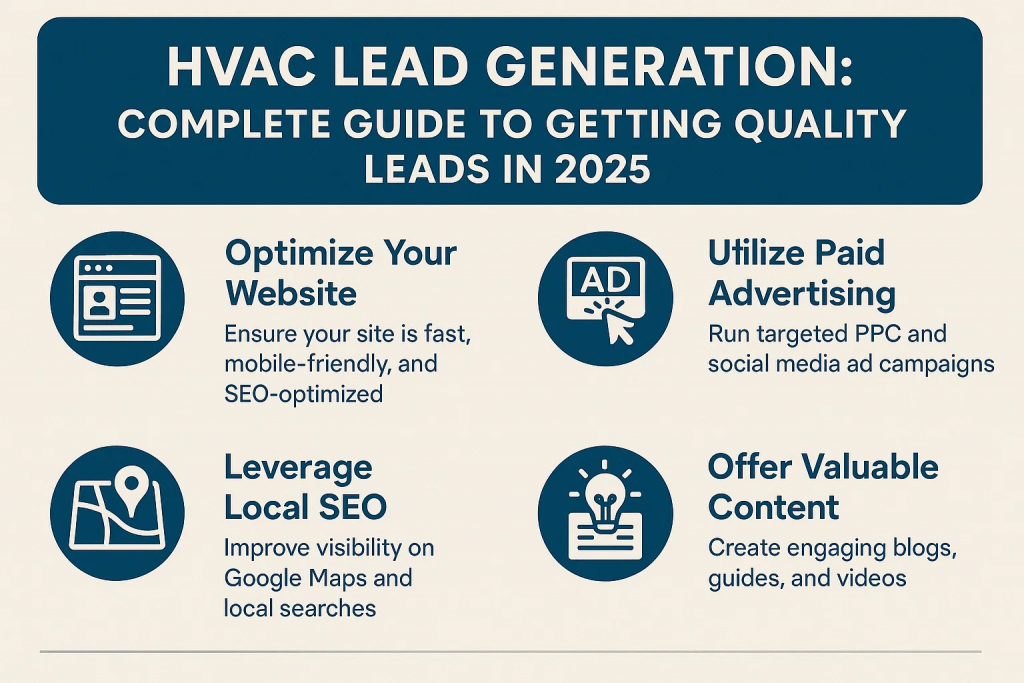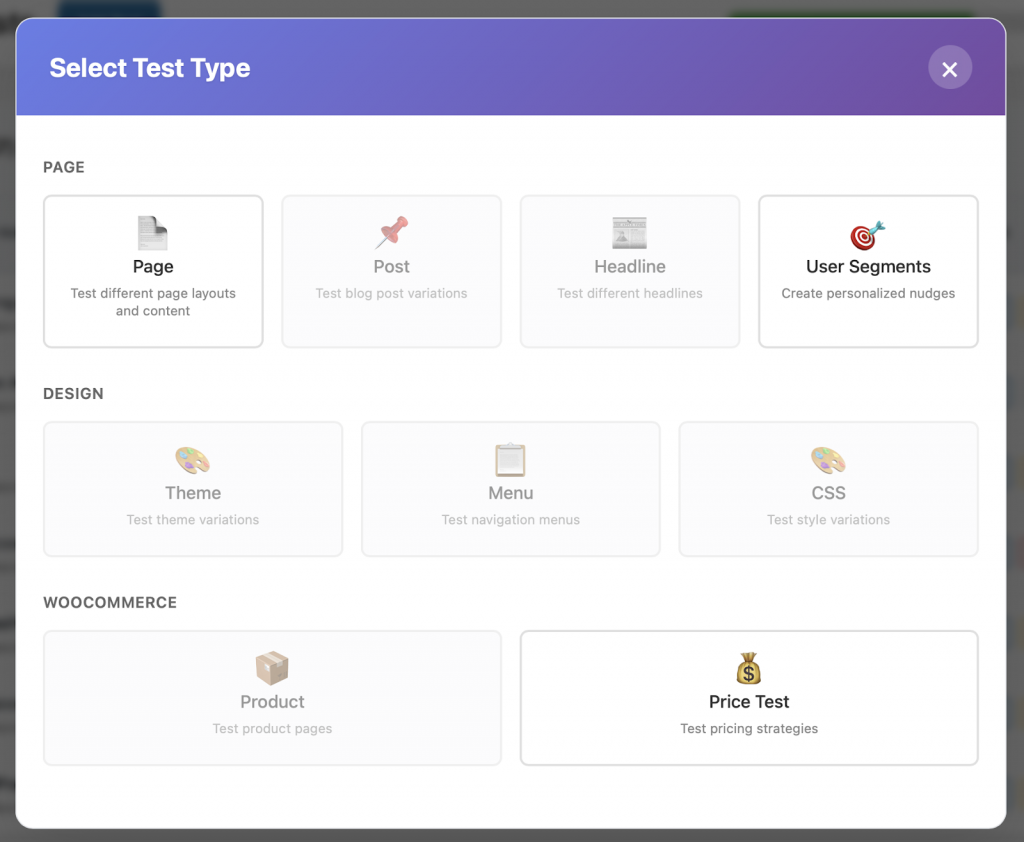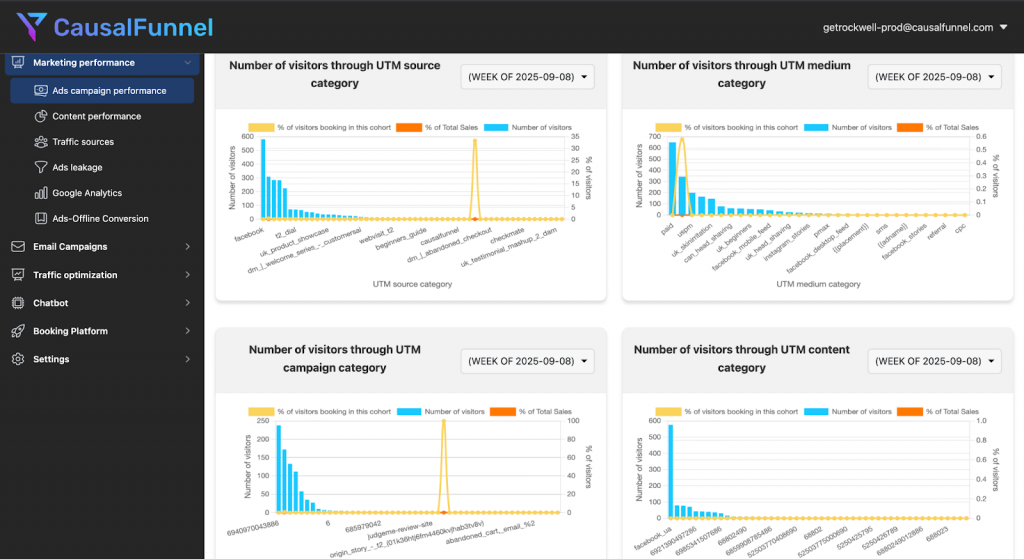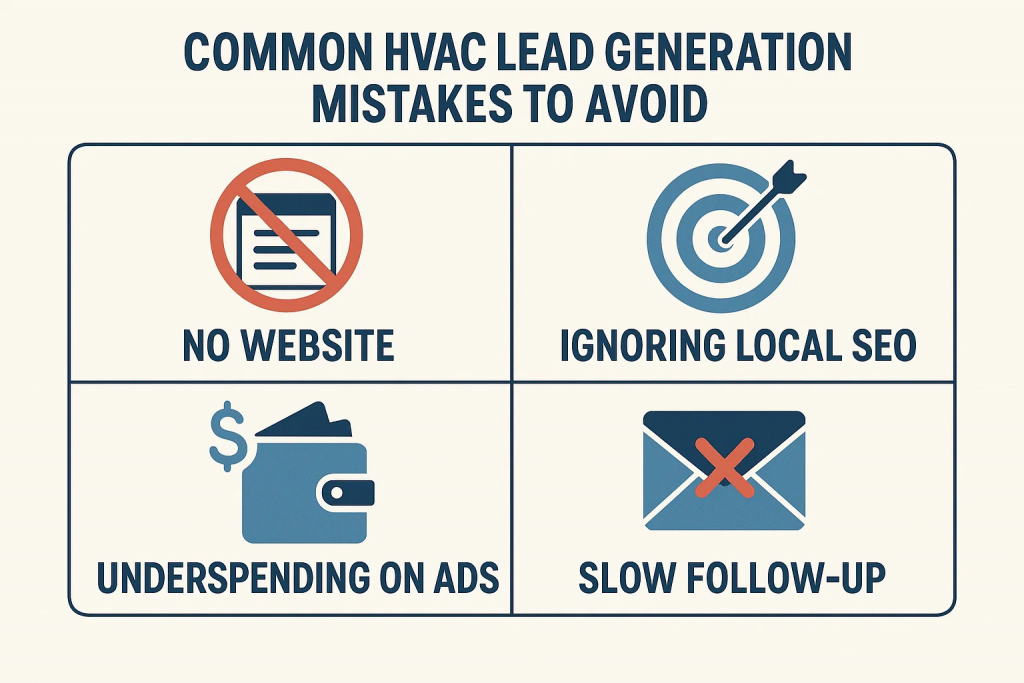The right lead today becomes tomorrow’s long-term customer, but you need to act faster. The HVAC industry continues to grow at an impressive pace. Market research shows the global HVAC market will reach $367 billion by 2030. This growth means more opportunities for contractors. But it also means more competition for customers. (Source)
Getting quality leads is the biggest challenge for HVAC contractors today. Many businesses struggle to find consistent sources of new customers. The old methods like word-of-mouth and Yellow Pages ads don’t work like they used to.
In 2025, successful HVAC contractors need a smart lead generation strategy. The digital landscape changes fast. Consumer behavior shifts constantly. Contractors who adapt will thrive. Those who don’t will fall behind.

What you’ll learn in this guide:
Choosing the right lead type is crucial for your business success. This decision directly impacts your conversion rates and profit margins. Understanding each option helps you make better investment choices.
The three main types of HVAC leads work differently. Each has unique benefits and challenges. Smart contractors match lead types to their business goals.

Exclusive HVAC leads go to only one contractor. These come from company websites, Google Business profiles, or direct phone calls. You don’t compete with other contractors for the same customer.
How A/B Testing Can Help?
Exclusive leads work best when your landing pages and forms convert visitors into real inquiries. Small design or content changes can make a big difference.
That’s where CausalFunnel’s A/B Test Platform comes in. A/B testing shows two versions of a page to visitors, with traffic split evenly, while detailed tracking helps measure performance and reveal which version drives more conversions.
A/B testing can help you figure out the latest headlines, button colors, form length, or call-to-action text. Over time, the system shows which version brings more conversions.
For example, a shorter form with fewer fields may attract more homeowners to sign up. A stronger headline may increase trust and encourage faster action.
Several contractors use A/B testing for proper structure, and with the help of a proper structure they avoid guesswork. This is where you can rely on data, not opinion, and it is going to improve results in the long run. This means more site visitors become paying customers. With exclusive leads, every small boost in conversion matters because of their higher cost.
Key characteristics of exclusive leads:

Shared leads get distributed to multiple contractors simultaneously. Usually 3-5 contractors receive the same customer information. The first to respond often wins the job.
The main advantage is lower cost per lead. You can get more leads for your marketing budget.
Smart use of an Ads Optimizer ensures your campaigns reach the right homeowners faster, improving your response times.
Benefits of shared leads:
Some agencies create leads specifically for your business. They build websites, run ads, and track calls for you. This is different from buying existing leads from a marketplace.
Quality varies significantly between different agencies. Some focus on volume while others prioritize conversion rates. The service level and support also differ widely.
Random marketing tactics waste time and money. A systematic approach produces consistent results. Follow this framework to build a sustainable lead generation system.
Successful contractors treat lead generation like a business process. They measure results, optimize performance, and scale what works. This methodical approach separates winners from strugglers.
Your 5-step framework:
Choosing the right platform makes or breaks your lead generation success. We evaluated these companies on pricing, quality, reviews, and contractor support. Each serves different business needs and budgets.
The platform landscape changes frequently. New companies emerge while others fade away. This analysis reflects current market conditions and contractor feedback.
Service Direct specializes in high-quality HVAC contractor leads. They use advanced call tracking and verification systems. Their leads come from targeted advertising campaigns.
The platform offers both exclusive and shared lead options. Pricing varies by market size and lead type. They provide detailed lead information including customer contact attempts.
Pros:
Cons:
Best for: Established contractors who prioritize quality over quantity.
Thumbtack operates as a marketplace connecting customers with contractors. You can buy HVAC leads through their bidding system. The platform covers most service areas nationwide.
Competition can be intense since multiple contractors bid on each project. Success requires quick responses and competitive pricing. The volume of available leads is substantial.
Pros:
Cons:
Best for: New contractors building their customer base and reputation.
99 Calls generates exclusive HVAC leads through organic marketing methods. They focus on SEO and content marketing rather than paid advertising. This approach often produces higher-intent customers.
Their leads typically cost more but convert at higher rates. The company provides detailed lead information and customer background. Response time requirements are less strict than shared lead platforms.
Pros:
Cons:
Best for: Quality-focused contractors with higher service pricing.
Billy.com offers upfront pricing for all lead types and markets. Their transparency helps contractors budget effectively. The platform focuses on residential HVAC services primarily.
They provide leads through both shared and exclusive arrangements. Customer verification includes budget confirmation and project timeline. The platform offers good contractor support resources.
Pros:
Cons:
Best for: Contractors who want predictable lead costs and transparent pricing.
CraftJack emphasizes fast lead delivery and response tracking. They monitor how quickly contractors respond to leads. The platform rewards fast responders with better lead quality.
Their system includes automated follow-up reminders and response tracking. Contractors can set availability schedules and lead preferences. The mobile app enables quick responses from anywhere.
Pros:
Cons:
Best for: Contractors with strong response systems and availability.
Generating your own leads builds long-term business value. You control the quality, timing, and customer experience. These strategies take more effort initially but create lasting competitive advantages.
Successful contractors combine multiple strategies for best results. Don’t rely on just one method for all your leads. Diversification protects against market changes and platform updates.

Google Business Profile optimization is essential for local HVAC leads. Complete your profile with photos, services, and current contact information. Encourage satisfied customers to leave positive reviews regularly.
Your website also needs strong local keyword optimization for service areas. Include city names, neighborhoods, and service types in your content. Create separate pages for different services and locations to rank higher.
This is where SEO Tools become powerful. They help contractors track rankings, find keyword gaps, and analyze competitors. With insights from tools like CausalFunnel SEO Tools, contractors will know exactly which keywords bring results. These insights improve visibility, attract qualified traffic, and reduce wasted effort.
Local SEO action checklist:
Educational content helps customers understand HVAC problems and solutions. Blog posts about common issues build trust and search rankings. Video content performs especially well for local service businesses.
Seasonal content timing matches customer needs throughout the year. Spring AC preparation and winter heating tips generate consistent traffic. Case studies showcase your expertise and problem-solving abilities.
Content ideas for HVAC contractors:
Paid advertising delivers immediate results when organic efforts take time. Google Ads work well for emergency repair services. Local Service Ads appear prominently in local search results.
Budget management is crucial for profitable paid advertising campaigns. Start small and scale successful campaigns gradually. Track phone calls, form submissions, and actual job bookings.
Google Ads campaign types:
Facebook and Instagram help showcase your work and team personality. Before-and-after photos demonstrate your capabilities visually. Customer testimonials and reviews build social proof.
Consistent posting keeps your business visible to local customers. Share helpful tips, behind-the-scenes content, and company updates. Respond promptly to comments and messages from potential customers.
Social media platform strategies:
Online reviews heavily influence customer decisions for local services. Positive reviews improve search rankings and conversion rates. Actively request reviews from satisfied customers after job completion.
Respond professionally to all reviews, both positive and negative. Thank customers for positive feedback publicly. Address concerns in negative reviews with solutions and contact information.
Review management best practices:
Different market segments require different lead generation approaches. Commercial and residential customers have unique needs, timelines, and decision-making processes. Understanding these differences improves your marketing effectiveness.
Lead generation costs and conversion rates vary significantly between segments. Commercial projects typically have higher values but longer sales cycles. Residential work offers quicker decisions but smaller project sizes.
Commercial customers include facility managers, building owners, and property management companies. Decision-making involves multiple people and longer evaluation processes. Relationship building is more important than quick responses.
Commercial projects often involve planned maintenance contracts and scheduled replacements. The sales cycle can extend from months to over a year. However, customer lifetime values are typically much higher.
Commercial lead generation strategies:
Average commercial contract values range from $10,000 to $100,000 or more. Sales cycles typically last 3-12 months depending on project complexity.
Residential customers often need immediate solutions for comfort problems. Emergency repairs and system failures create urgent buying situations. Trust and local reputation matter more than extensive sales presentations.
Seasonal patterns significantly affect residential demand throughout the year. Summer and winter peak seasons generate the most emergency calls. Spring and fall are better for planned maintenance and replacements.
Residential lead tactics:
Seasonal demand patterns show highest activity in summer and winter months. Emergency repairs typically range from $200-2,000 while system replacements average $5,000-15,000.
Generating leads is only half the equation for business success. Converting leads into paying customers determines your actual return on investment. Proper systems and processes maximize your lead conversion rates.
Many contractors lose potential customers through poor follow-up and slow responses. Technology tools help automate follow-up while maintaining personal connection. The goal is consistent, professional customer communication.
Understanding which marketing channels produce your best customers guides future investments. Track lead sources, conversion rates, and customer lifetime values for each channel. This data helps optimize your marketing budget allocation.
Customer relationship management systems organize lead information and automate follow-up tasks. Integration with phone systems and email platforms creates seamless workflows. Detailed tracking reveals which tactics produce the highest-value customers.
Essential tracking elements:
Fast response times dramatically improve HVAC contractor leads conversion rates. Studies show response within 5 minutes increases conversion by 400%. Automated systems help maintain consistent response speeds even during busy periods.
Follow-up sequences keep your business visible to prospects over time. Many customers need multiple contacts before making purchase decisions. Automated email and text sequences maintain contact without overwhelming prospects.
Automation tools for follow-up:
Not all leads deserve equal time and attention investment. Qualification criteria help prioritize high-value prospects over low-probability opportunities. Spend more time on leads with higher closing potential.
Lead scoring systems rank prospects based on multiple factors. Budget, timeline, decision authority, and service type all affect closing probability. Focus your best sales efforts on the highest-scoring opportunities.
Qualification criteria checklist:
Website and landing page optimization improves lead generation effectiveness. Clear calls-to-action and professional design build customer confidence. Social proof through reviews and testimonials increases conversion rates.
Sales process improvement focuses on customer needs rather than company capabilities. Listen more than you talk during sales conversations. Present solutions that match customer priorities and budget constraints.
Optimization strategies:
Industry conversion rate benchmarks range from 10-25% for quality leads. Emergency repair leads typically convert at higher rates than planned replacement projects.
Marketing budget allocation directly impacts your business growth potential. Most successful contractors invest 5-10% of revenue in lead generation activities. Proper planning prevents overspending while ensuring adequate lead flow.
Balance short-term lead purchasing with long-term relationship building investments. Buying leads provides immediate results while organic strategies build lasting value. The optimal mix depends on your business stage and growth goals.
Diversify your marketing investments across multiple channels for stability. The 60/30/10 rule works well for most contractors. Invest 60% in proven channels, 30% in optimization, and 10% in testing new approaches.
Seasonal budget adjustments match customer demand patterns throughout the year. Increase spending before peak seasons while reducing investment during slower periods. Emergency repair marketing works year-round while replacement advertising peaks seasonally.
Budget allocation framework:
Different marketing channels produce leads at varying costs and quality levels. Track cost per lead alongside conversion rates for accurate ROI comparison. The cheapest leads aren’t always the most profitable.
Organic SEO leads cost less long-term but require significant upfront investment. Paid advertising provides immediate results at higher per-lead costs. Referrals typically cost the least but depend on existing customer satisfaction.
Typical cost per lead ranges (Approx):
Quality considerations affect the true value of leads regardless of cost. Higher-converting leads justify higher acquisition costs through better ROI.
Key performance indicators help track lead generation effectiveness over time. Monitor cost per lead, conversion rates, and customer lifetime value monthly. Use this data to optimize your best-performing channels.
Regular performance reviews identify trends and opportunities for improvement. Compare different HVAC lead generation companies and channels objectively using data. Make investment decisions based on actual results rather than assumptions.
Essential KPIs for tracking:

Learning from common mistakes saves time, money, and frustration. These pitfalls trip up many contractors starting their lead generation efforts. Awareness helps you avoid these costly errors.
Putting all marketing eggs in one basket creates dangerous vulnerability. Platform changes, market shifts, or increased competition can eliminate your entire lead flow. Diversification protects against these risks.
Focusing only on lead quantity without measuring conversion rates wastes money. Cheap leads that don’t convert cost more than expensive leads that close. Track quality metrics alongside volume measurements.
Leads lose interest fast. Waiting even a day can cut conversion rates in half. Fast contact wins jobs. Without data, you can’t see what works. Missing tracking means repeating mistakes instead of scaling success.
Treating every lead as immediate-or-never misses many opportunities. Many customers need time to research, budget, and decide. Systematic follow-up captures these delayed conversions.
No Website Presence
Some contractors still rely only on word of mouth. Without a website, you lose visibility and trust.
If you don’t optimize for local searches, you miss customers looking for “HVAC near me.”
Marketing without measurement leads to wasted spending on ineffective tactics. Set up tracking systems before launching campaigns. Data-driven decisions outperform gut feelings consistently.
Technology continues changing how customers find and choose HVAC contractors. Staying ahead of trends provides competitive advantages in local markets. Early adopters often capture market share from slower competitors.
Consumer behavior shifts toward digital research and online booking preferences. Voice search and mobile optimization become increasingly important for local businesses. Video content grows in importance for service demonstrations.
Key trends shaping the future:
AI and Automation Integration – The AI Shopping Buddy adds another layer of support. It works as a smart assistant for HVAC businesses, guiding visitors, answering questions, and even helping them book services. This improves response time, builds trust, and converts more site visitors into paying customers.
Voice Search Optimization – Smart speakers change how customers search for local services. Optimize content for conversational queries and location-based voice commands.
Video Marketing Dominance – YouTube tutorials and virtual consultations become standard customer expectations. Video content explains complex HVAC concepts better than written descriptions.
Hyper-Local Targeting – Advanced targeting reaches customers in specific neighborhoods and zip codes. Community-based marketing becomes more important than broad geographic campaigns.
Effective HVAC lead generation separates thriving contractors from struggling ones in today’s competitive market. The strategies and platforms covered in this guide provide multiple paths to business growth. Success requires consistent effort, smart planning, and continuous optimization.
Start with a systematic approach rather than random marketing experiments. Choose 2-3 lead sources that match your budget and capabilities. Track results carefully and reinvest in your best-performing channels.
Building a sustainable HVAC leads pipeline takes time but creates lasting business value. The contractors who invest in lead generation systems today will dominate their markets tomorrow. Your customers need your services – make it easy for them to find you.
Take action with these next steps:
Lead costs vary from $15-200 depending on type and quality. When you buy HVAC leads, exclusive leads cost more but convert better. Shared leads cost less but face more competition.How many leads does an HVAC contractor need per month?
Most contractors need 50-100 leads monthly to maintain steady growth. New businesses may need more to build a customer base. Established companies with referrals may need fewer purchased leads.
Exclusive HVAC leads convert at higher rates but cost significantly more. Shared leads provide volume at lower costs but require faster response. Your budget and capabilities determine the best choice.
Respond within 5 minutes for best results with purchased leads. Emergency repairs need immediate responses while planned projects allow longer response times. Speed usually beats perfection for initial contact.
New contractors should start with lower-cost shared lead platforms. Build experience and systems before investing in expensive exclusive leads. Focus on response speed and customer service quality.
Track lead source, cost per lead, conversion rates, and customer lifetime value. HVAC lead generation ROI improves when you focus spending on highest-converting sources. Use CRM systems for accurate tracking.
Most successful contractors do both for optimal results. Buying leads provides immediate income while organic generation builds long-term value. Start with purchasing leads then add DIY strategies gradually.
Quality HVAC leads include verified contact information, confirmed budgets, and realistic timelines. Customers should be decision-makers with actual service needs. HVAC lead generation works best with pre-qualified prospects.
Empowering businesses to optimize their conversion funnels with AI-driven insights and automation. Turn traffic into sales with our advanced attribution platform.



